
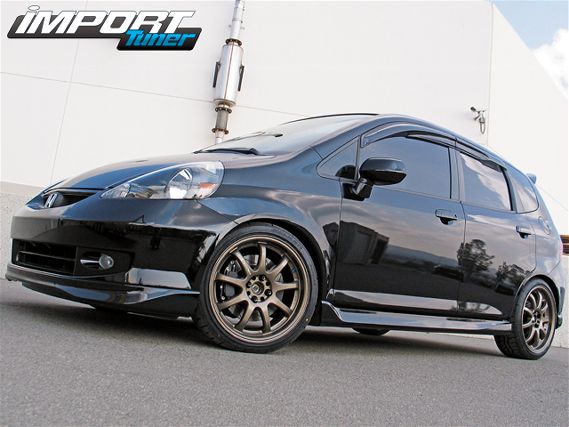 | Power Pages - Honda Fit
| Power Pages - Honda Fit The Honda Fit models sold in the U.S. are equipped with a 1.5-liter, SOHC, 16-valve 4-cylinder VTEC engine that generates 108 horsepower and 105 lb-ft of torque. While horsepower numbers are nothing to brag about to your friends, the Fit has quickly established itself as the new cult icon among Honda enthusiasts around the world. Boasting amazing 38mpg fuel efficiency, this mild mannered sub-compact vehicle is often the debate of whether it's a family car or performance vehicle. With the increase in popularity among the Honda Fit, we found it only logical to perform a Power Page test to see how the newest Honda would respond with some aftermarket bolt-on components.
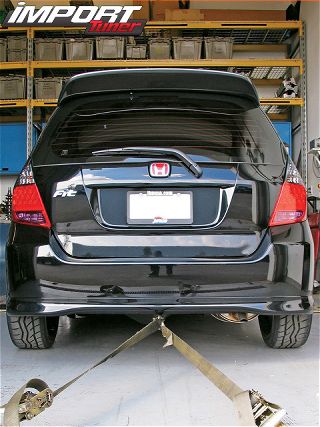 | Power Pages - Honda Fit
| Power Pages - Honda Fit Found within the internal workings of the Fit engine are numerous friction-reducing technologies that include roller bearing tipped rocker arms, a low-friction timing chain tensioner, molydebenum-coated piston skirts and an offset crankshaft/connecting rod design. This all adds up to improved gas economy and engine longevity, but for those who think the Fit is some rocket ship built on four-wheels are in for a big disappointment. The 1.5-liter displacement is a definite thorn in the Achilles heel for the Honda Fit. The lack of displacement, power and torque can often be frustrating, especially when coming face to face with a K20-powered Civic that decides to punk you, as you helplessly drive along in frustration.
With 4,000 miles on the odometer, this Honda Fit served as the perfect candidate in receiving some much-needed horsepower.
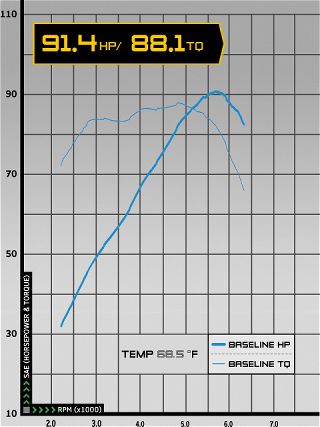 | Power Pages - Honda Fit
| Power Pages - Honda Fit Baseline
2007 Honda Fit
Owner: Sheng Chao
Dynamometer Model: Superflow Dynamometer
Testing and Photos: Scott Tsuneishi
PEAK HP 91.4 / PEAK TQ 88.1
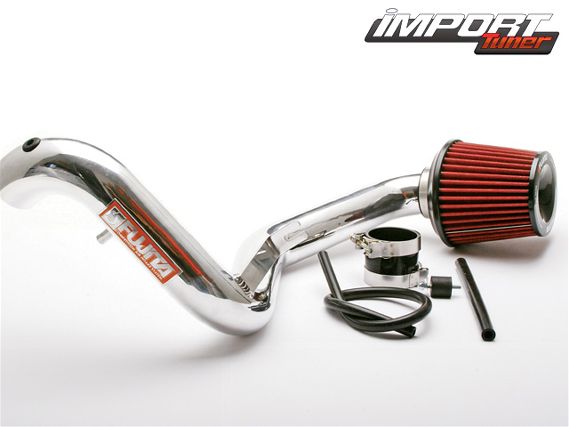 | Power Pages - Honda Fit
| Power Pages - Honda Fit Fujita F5 recently debuted two new intake designs for the Honda Fit. The Fujita team now offers the consumers an option of either a short ram intake (SR-1924); designed to fit both manual and automatic transmission vehicles, or their popular cold air intake system (CA-1924). When comparing the factory intake to the Fujita Super Flow filter, it's obvious that the surface area and flow capacity of the new filter is a major improvement.
Due to the larger sized transmissions found on the automatic Fit, the Fujita cold air intake is limited to manual transmission vehicles only. Knowing well at hand that this was a major drawback for those sporting the automatic gearbox, Fujita designed their short-ram intake system to work with both auto and manual transmission vehicles. When installing the cold-air intake system, we found it necessary to make minor adjustments to the intake pipe positioning and mounting angle, ensuring the filter has enough clearance for the underpanel splash guard to properly re-attach.
6061 T6 polished aluminum intake, carbon-plated T-blot clamps, Hose Techniques silicone hose, rubber vibration mount, brackets, and Fujita Super Flow air filter, duffel bag, hat, NOS energy drink, stickers and instructions
10mm socket, ratchet, screwdriver, needle nose pliers and razor blade
45 minutes
Installation of the Fujita cold-air intake was a straightforward procedure thanks to the detailed instructions included with the kit. Installing the cold-air intake requires removing the coolant crankcase hard line and replacing it with an 8mm heater hose to the throttle body. With some minor trimming to the factory splashguard, the rest of the intake slides easily into place without a hitch. Dyno graphs displayed a healthy increase in both horsepower and torque throughout the entire powerband. We were impressed with the consistent gain of 5hp and 4 lb-ft of torque over baseline from 5500 to redline.
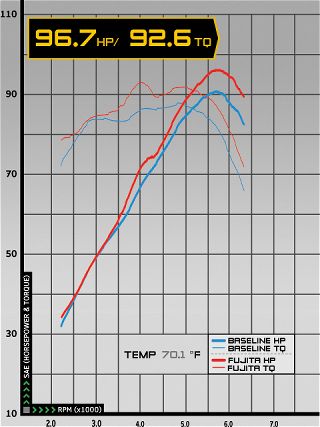 | Power Pages - Honda Fit
| Power Pages - Honda Fit Fujita F5 Cold Air Intake System
PEAKHP 96.7 / PEAKTQ 92.6
Horsepower Gain
1500 to 3500 HP range: 2 to 1
3500 to 5500 HP range: 1 to 5
5500 to redline HP range: 5 to 5
Torque Gain
1500 to 3500 TQ range: 5 to 1
3500 to 5500 TQ range: 2 to 5
5500 to redline TQ range: 4 to 4
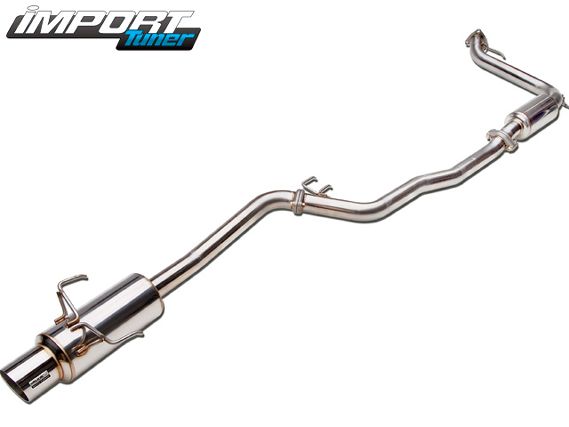 | Power Pages - Honda Fit
| Power Pages - Honda Fit The Skunk2 racing cat-back exhaust system is constructed with 60mm (2.36 inch) T-304 stainless steel mandrel-bent tubing to ensure maximum flow over the factory unit. Designed as a true cat-back exhaust system for the Honda Fit, the Skunk2 system seemed to be the logical choice, as we found the competitor's version only offering an axle-back, bolt-on exhaust unit. Quality features found on the Skunk2 exhaust system are the single 110mm diameter polished tip with acid-etched Skunk2 Mega Power badge and serialized nameplate. Using a fully polished muffler and resonator with semi-finished satin tubing, this exhaust system also comes with a removable silencer. Also available is a 50mm setup while the 60mm system was designed for modified motors that include forced induction.
While installation of the new exhaust was a simple procedure, the removal of the factory exhaust required us to spray the rubber exhaust bushings with plenty of grease to finagle the hangers loose. Receiving some assistance when removing the exhaust is always helpful.
Exhaust, exhaust flange, B-pipe, nuts and bolts, stickers, instructions and brackets
12- and 14mm combination wrench, 12- and 14mm socket, ratchet, extension and wobble socket
60 minutes
Knowing Skunk2 had two exhaust systems available for the Honda Fit; we opted to go with the 60mm unit knowing we would be installing additional parts on the vehicle later on. As expected, there wasn't much of a change in terms of horsepower increase within the 2000 to 4000rpm rpm range but did notice a pickup of anywhere from 2 to 4hp at the higher rpms. Obviously the high flow exhaust system was beneficial in reducing exhaust backpressure while increasing ponies.
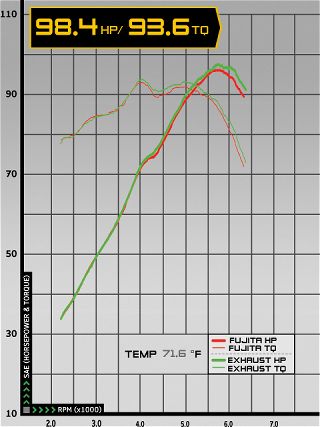 | Power Pages - Honda Fit
| Power Pages - Honda Fit Skunk2 Mega Power Exhaust
PEAKHP 98.4 / PEAKTQ 93.6
Horsepower Gain
1500 to 3500 HP range: 0 to 1
3500 to 5500 HP range: 1 to 3
5500 to redline HP range: 2 to 3
Torque Gain
1500 to 3500 TQ range: 0 to 1
3500 to 5500 TQ range: 1 to 3
5500 to redline TQ range: 2 to 3
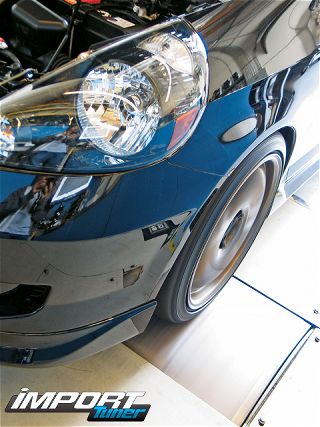 | Power Pages - Honda Fit
| Power Pages - Honda Fit With no less than 24 hours before we were to commence testing on the Honda Fit, 2NR received a billet crank pulley hot off the CNC machine from Unorthodox Racing. Designed by the Unorthodox engineers as a replacement crank pulley for the Fit, this lightened aluminum stock diameter crank pulley lacks the underdrive feature which many consumers often shy away from. While underdrive does help improve overall horsepower gains, too much of it can cause charging problems within the electrical, power steering and water pump on your vehicle.
If you know how to change your underwear, then replacing your factory crank pulley with an Unorthodox unit shouldn't require brain surgery. Using an air compressor and impact gun will definitely make life easier when attempting to remove the crank pulley bolt. Just be sure to re-torque the crank bolt to factory specification.
Crank pulley, stickers, and instructions
19-mm socket, ratchet and compressor gun
60 minutes
Mechanical theory states that anytime weight is removed from a rotational mass, such as a crankshaft, will increase horsepower and torque. In this case, we used a lightened crank pulley to test this theory on the Honda Fit. Exactly how lightweight is the Unorthodox crank pulley? We weighed in the new crank pulley at 1.20 pounds while the factory unit came in at 5.05 pounds. A spin on the dyno revealed respectable horsepower and torque from 2000rpm till redline with a consistent gain of 2hp from 2000 to 4000rpm as a 4 lb-ft of torque gain over our previous exhaust run was displayed at 2000rpm to 5000rpm.
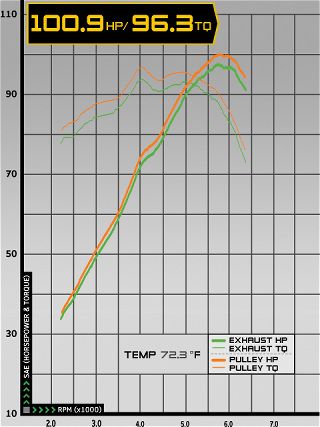 | Power Pages - Honda Fit
| Power Pages - Honda Fit Unorthodox Racing Crank Pulley
PEAKHP 100.9 / PEAKTQ 96.3
Horsepower Gain
1500 to 3500 HP range:2 to 2
3500 to 5500 HP range: 2 to 3
5500 to redline HP range: 3 to 4
Torque Gain
1500 to 3500 TQ range: 4 to 4
3500 to 5500 TQ range: 3 to 4
5500 to redline TQ range: 2 to 3
 | Power Pages - Honda Fit
| Power Pages - Honda Fit With 10hp and 8 lb-ft of torque over our baseline run, we considered this dyno session a complete success. Taking into consideration the Fit's engine displacement and economy setup engine design, our newly outfitted Fit was now ready for a free-flowing header and a possibly fuel management-hell, how about a camshaft? Any manufacturers willing to heed the call?
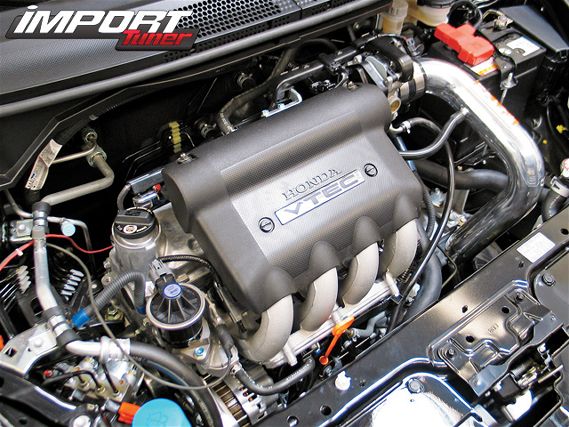 | Power Pages - Honda Fit
| Power Pages - Honda Fit Fujita F5 Cold Air Intake System (CA- 1924)
$ 248.00
Skunk2 Fit Mega Power Exhaust
$598.45
Unorthodox Racing Crank Pulley
$ 199.9
MSRP Total: $ 1046.44
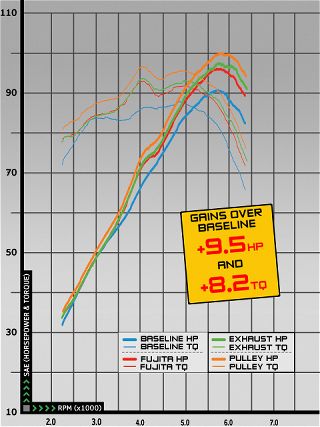 | Power Pages - Honda Fit CONCLUSION HP Level +HPTQ Level +TQBaseline91.4 88.1Fujita F5 Cold Air Intake System96.75.392.64.5Skunk2 Fit Mega Power Exhaust98.41.793.61.0 Unorthodox Racing Crank Pulley{{{100}}}.92.596.32.7Final100.99.596.38.2
| Power Pages - Honda Fit CONCLUSION HP Level +HPTQ Level +TQBaseline91.4 88.1Fujita F5 Cold Air Intake System96.75.392.64.5Skunk2 Fit Mega Power Exhaust98.41.793.61.0 Unorthodox Racing Crank Pulley{{{100}}}.92.596.32.7Final100.99.596.38.2
